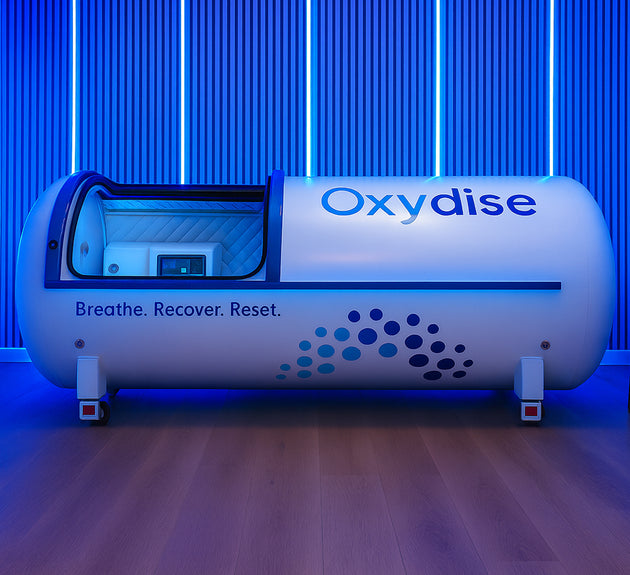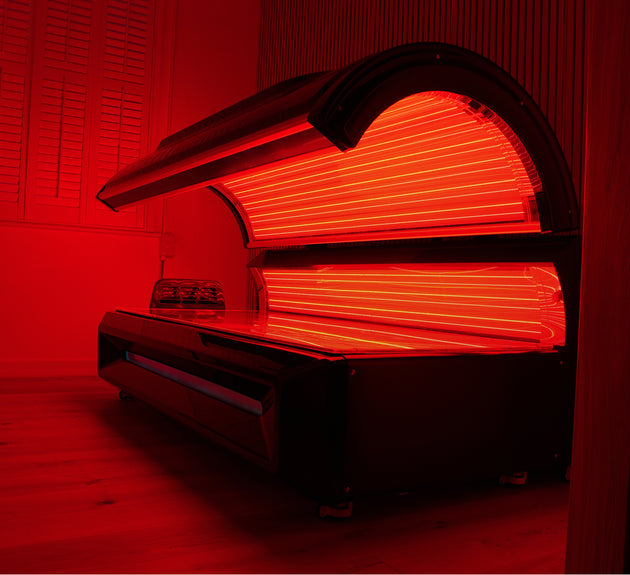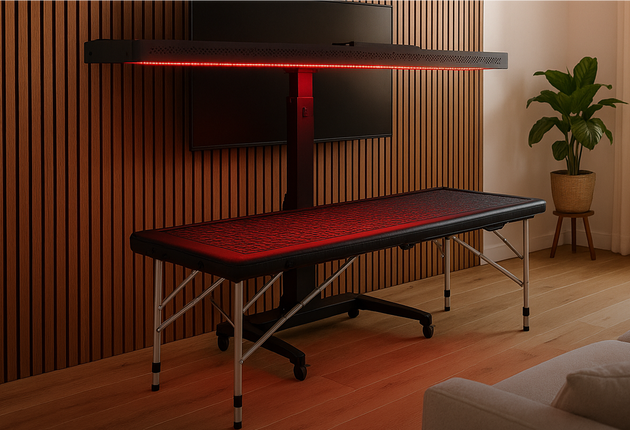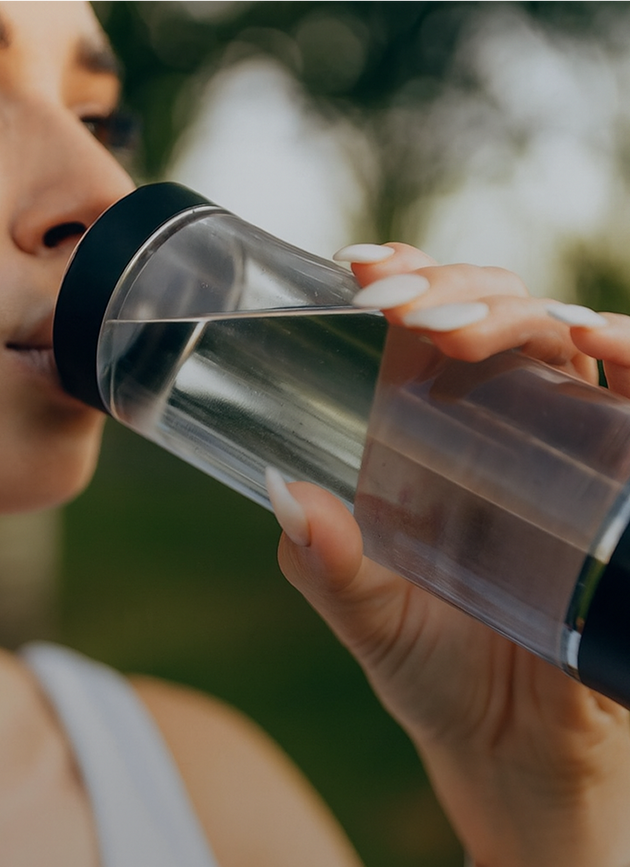1. What Is Red Light Therapy (RLT)
Red Light Therapy (RLT), also known as photobiomodulation, is a non-invasive treatment that uses specific wavelengths of red and near-infrared light to stimulate energy production inside your cells.
At Oxydise, we offer two advanced forms of RLT:
-
Full-Body Red Light Panel System – a vertical array of high-intensity LEDs that allows you to stand or recline in front of the light for complete head-to-toe exposure.
Each session bathes the body in a precise spectrum of red (630–660 nm) and near-infrared (810–850 nm) light, supporting skin renewal, muscle recovery, circulation, and overall vitality. -
NeuroGamma Headset – a specialised near-infrared device designed for the brain, delivering pulsed 810 nm light to support focus, mood, and cognitive recovery.
Both systems work by delivering safe, targeted light energy to the body’s mitochondria — the tiny “power plants” inside every cell — helping them produce more ATP (cellular energy).
More energy means faster repair, reduced inflammation, and a calmer, more balanced nervous system.
2. What RLT Does for the Body
Light is energy, and your body’s cells are designed to use it. When red and near-infrared light are absorbed by the mitochondria (the energy centres of your cells), they stimulate the production of ATP — your body’s energy currency.
With more cellular energy available, your body can repair faster, reduce inflammation, and restore balance more effectively.
The results can include:
-
Smoother, brighter skin through increased collagen and elastin
-
Reduced soreness and inflammation in muscles and joints
-
Faster recovery after training or injury
-
Improved circulation and oxygen delivery
-
Calmer mood and steadier sleep patterns
In short, RLT helps your body work more efficiently — inside and out.
3. Safety of Red Light Therapy
Red Light Therapy is one of the gentlest and safest forms of natural energy treatment available. It’s non-invasive, drug-free, and free from UV rays, making it safe for most adults to use regularly.
All Oxydise equipment is CE and UKCA certified, and our full-body bed is built with controlled intensity and medical-grade LEDs. Sessions are short (10–20 minutes) and can be done daily or several times per week.
Red light is not harmful to the eyes; however, protective goggles are available if you are light-sensitive or simply prefer them.
For detailed information on safety, contraindications, and best practices, see our Safety at Oxydise page.
4. Understanding Wavelengths — Red vs Near-Infrared
Red and near-infrared light work together but reach different depths:
-
Red light (630–660 nm) — acts mainly on the skin’s surface and upper layers, stimulating collagen, reducing redness, and improving texture.
-
Near-infrared (810–850 nm) — penetrates much deeper, helping muscles, connective tissue, and nerves repair and recover.
By combining both ranges, Oxydise RLT delivers a full-body effect — promoting surface rejuvenation and deep recovery at the same time.
5. Why Light Quality and Design Matter
Not all red light systems are created equal. The power, wavelength precision, and LED density all determine how effectively light energy reaches your tissues.
The Solaris Elite bed at Oxydise uses over 42,000 high-intensity diodes, ensuring even, full-body coverage and consistent energy delivery.
Its temperature-controlled base and soft-touch design make sessions both comfortable and clinically effective — no hot spots, no uneven exposure.
6. Who Can Use RLT
RLT suits almost anyone seeking faster recovery, better skin, and balanced wellbeing. It’s used by:
-
Athletes to improve recovery and reduce soreness
-
People managing chronic pain or inflammation
-
Clients focused on skin health, anti-ageing, and collagen support
-
Individuals dealing with fatigue, stress, or poor slee
-
Anyone seeking a safe, non-invasive way to recharge cellular energy
Our team reviews every client’s goals and ensures correct exposure times and session spacing for your needs.
7. What Benefits You Can Expect
Red Light Therapy works cumulatively — results strengthen with each session.
Here’s a general timeline based on real client outcomes at Oxydise:
After 5 sessions
Skin feels softer and more hydrated; mood lifts; early reduction in stiffness and soreness.
After 10 sessions
Brighter, smoother skin tone; faster post-training recovery; deeper, more consistent sleep.
After 20 sessions
Visible reduction in fine lines, redness, and swelling; stronger mood balance and focus; noticeable circulation improvements.
After 40+ sessions
Long-term collagen renewal, reduced chronic inflammation or pain, and sustained energy and vitality.
8. A Typical RLT Session — What to Expect
Your session begins by removing makeup, sunscreen, or heavy lotions from the areas you’d like treated. Comfortable clothing is fine, but for best results, expose as much skin as possible.
You’ll lie back on the temperature-controlled bed as soft red and near-infrared light begins to glow around you. There’s no discomfort — just gentle warmth.
Sessions last 10–20 minutes, and many clients combine them with HBOT, PEMF, or IV nutrient therapy for a complete recovery experience. Afterwards, drink water and go about your day — no downtime, no side effects.
9. Safety Considerations and When to Seek Advice
RLT is safe for most people, but there are a few situations where caution or medical advice is recommended:
-
Avoid full-body or abdominal use during pregnancy
-
Do not use if you have active cancer or are undergoing chemotherapy
-
Avoid if taking photosensitising medications (certain antibiotics, acne or depression drugs)
-
Seek advice if you have epilepsy triggered by light
If in doubt, speak to our team or your doctor before starting sessions.
10. Fascinating Facts About RLT
-
RLT was first studied by NASA to help astronauts heal wounds and prevent bone loss in space.
-
Red and near-infrared light can increase energy production in cells by up to 200%.
-
Regular use stimulates collagen — nature’s own structural protein — making skin firmer and smoother.
-
The light triggers nitric oxide release, improving blood flow and oxygen delivery throughout the body.
-
RLT complements HBOT beautifully: oxygen feeds the cells, and red light helps them use that oxygen more efficiently.
In Summary
Red Light Therapy is one of the simplest and most natural ways to support your body’s ability to recover, rejuvenate, and perform. By recharging your cells with gentle, targeted wavelengths, it promotes energy, balance, and visible health from within.
At Oxydise, we use medical-grade systems, precise wavelength calibration, and expert guidance to ensure every session is safe and effective. Whether you’re improving recovery, boosting energy, or refining skin tone, RLT can be an essential part of your wellness routine.
















